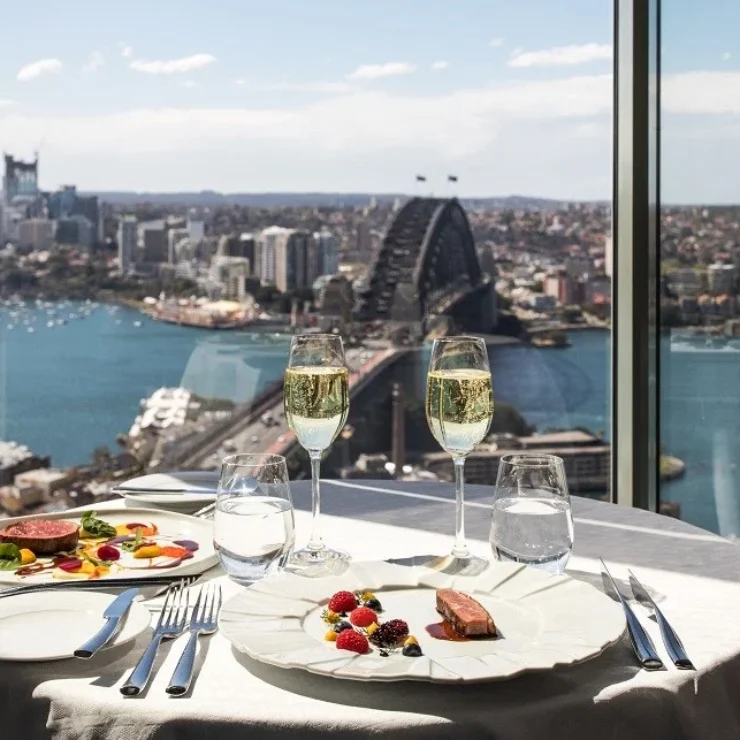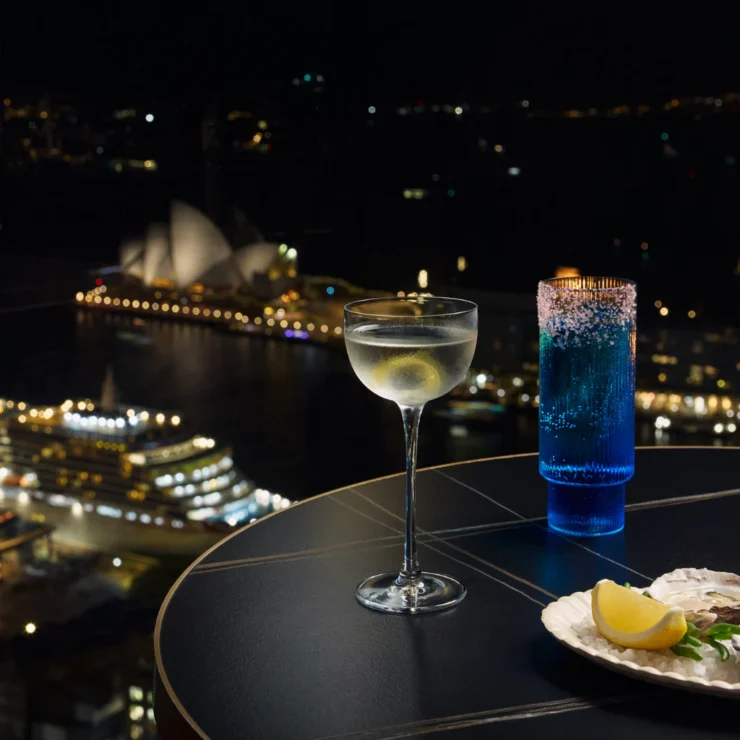While the panoramic harbor views from your Shangri-La Sydney window might tempt you to stay in your room forever, just steps from the hotel’s grand entrance lies one of Australia’s most fascinating historical neighborhoods. The Rocks—Sydney’s birthplace and first European settlement—offers a compelling counterpoint to your elevated luxury experience. This cobblestoned precinct, with its hidden laneways, sandstone buildings, and stories etched into every corner, invites you to descend from your lofty perch and explore Sydney’s rich colonial past and vibrant present.
Your Privileged Starting Point
The Shangri-La Sydney enjoys a position that history-loving travelers would envy—perched at the neighborhood’s edge where the modern city meets its oldest streets. Your exploration begins the moment you exit the hotel’s Cumberland Street entrance, bypassing the need for taxis or public transport. This prime location allows you to experience The Rocks in ways day-visitors cannot—during the magical early morning light before tour buses arrive, or after sunset when lanterns illuminate the historic facades.
Understanding The Rocks: Sydney’s Living Museum
Before setting out, appreciate what makes this neighborhood so significant. The Rocks marks the precise spot where Captain Arthur Phillip planted the British flag in 1788, establishing the colony of New South Wales. Originally home to the Gadigal people of the Eora Nation for thousands of years prior, this peninsula of sandstone ridges (hence the name “The Rocks”) became the rough-and-tumble heart of colonial Sydney—a place of convicts, sailors, whalers, and eventually merchants who built the sandstone warehouses and residences that remarkably survive today.
While many historical districts worldwide have been reconstructed or heavily modified, The Rocks offers something rare: authentic colonial-era structures that have survived against considerable odds, including early 20th-century demolition plans and redevelopment pressures. What you’ll walk through isn’t a re-creation but the actual streets and buildings where Sydney’s European story began.
Morning Exploration: The Empty Streets Advantage
One of the greatest luxuries your Shangri-La stay affords is experiencing The Rocks before the crowds arrive. Set your alarm for dawn—you can sleep in another day—and head out as first light bathes the sandstone in a golden glow.
6:30-8:30 AM Walking Route: “The Colonial Awakening”
- Exit the Shangri-La’s Cumberland Street entrance and turn left, then immediate right onto Gloucester Walk
- Follow this elevated pathway for spectacular early harbor views without tourists
- Descend the sandstone Suez Canal stairs to George Street
- Pause at La Renaissance Patisserie (47 Argyle Street) as it opens at 7 AM for authentic French pastries—their almond croissants pair perfectly with the morning atmosphere
- Continue along Kendall Lane with its perfectly preserved gas lamps and brick paving
- Loop around to Foundation Park on Argyle Street—an archaeological site and former tenement housing rarely visited before 9 AM
- Return via Nurses Walk, a narrow passage once home to the colony’s first hospital
During these quiet morning hours, you might spot local residents walking dogs or shopkeepers preparing for the day. The air carries traces of sea salt from the harbor, and the low morning sun illuminates sandstone walls with a warmth photographers chase but rarely capture. This is The Rocks as locals experience it—before it dons its tourist-facing persona.
Historical Landmarks: Beyond the Obvious
While any guidebook lists the area’s major attractions, your Shangri-La proximity allows a more nuanced exploration. Instead of rushing between famous sites, consider this carefully sequenced journey that reveals The Rocks’ layers of history:
The Essential Historical Circuit (Allow 3-4 hours)
- Cadman’s Cottage (110 George Street) – Sydney’s oldest surviving residential building (1816) stands as a testament to early colonial architecture. Ask at the visitor center inside about how the shoreline once reached this cottage’s door before land reclamation pushed the harbor back.
- Susannah Place Museum (58-64 Gloucester Street) – This row of four terraced houses built in 1844 offers a rare glimpse into working-class life across different eras. The museum preserves interiors from the 1840s to the 1970s. Pre-book the “Hints & Tips” tour where guides demonstrate Victorian household techniques—everything from starching collars to natural pest control.
- The Big Dig Archaeological Site (Cumberland Street) – Beneath the Sydney Harbour YHA hostel lies an archaeological treasure accessible via guided tour. Excavations revealed foundations and artifacts from dozens of early colonial homes, telling intimate stories of the first settlers. The youth hostel above was specifically designed to preserve these ruins—an architectural achievement worth seeing even if you’re not interested in archaeology.
- Campbell’s Storehouses (7-27 Circular Quay West) – These impressive sandstone warehouses once stored whale oil, wool, and other colonial exports. Now housing restaurants and shops, their impressive masonry reveals the craftsmanship of convict labor. Look closely at certain blocks to find the maker’s marks of individual stonemasons—some carved initials or symbols as a subtle form of rebellion.
- Garrison Church (corner of Argyle Street and Lower Fort Street) – The oldest church in The Rocks (1840) features original cedar box pews and military memorabilia reflecting the role of British regiments in colonial Sydney. The stained glass commemorates military units, and the church remains active for Sunday services—visitors are welcome.
Hidden Passageways and Secret Corners
While most tourists stick to George and Argyle Streets, your extended time in the neighborhood allows discovery of forgotten laneways and viewpoints that tell deeper stories:
- Suez Canal – This narrow, steep stairway between Cumberland and Harrington Streets got its nickname from workers who likened navigating it to passing through the actual canal. Morning light creates dramatic shadows across its worn steps.
- Foundation Park – Hidden on the slopes of Argyle Street, this open-air museum preserves the foundations of eight worker cottages built into the steep cliff face in the 1870s. Metal sculptures outline where walls, fireplaces, and furniture once stood—a ghostly reminder of cramped living conditions.
- Atherden Street – Possibly Sydney’s shortest street, this tiny passage contains perfectly preserved workers’ cottages. The street is so narrow that neighboring residents could reportedly shake hands from their windows across the lane.
- Dawes Point Battery Remains – Walk under the Harbour Bridge to find archaeological remains of Sydney’s first fortification, built in 1791. Few tourists venture here, but the location offers spectacular bridge views and historical significance as Sydney’s first observatory site.
- Crane plaque at 39-41 Argyle Street – Look up to spot a preserved cargo crane and pulley system on this historic warehouse, demonstrating how goods were moved before modern equipment. A small plaque explains its operation.
Culinary History: Tasting The Rocks Through Time
The Rocks’ dining scene offers more than convenience—it’s an opportunity to taste living history, with many establishments occupying buildings that have served food and drink for over a century:
- The Fortune of War (137 George Street) – Sydney’s oldest continuously licensed pub (1828) still serves traditional pub fare in its original location. Request a seat in the small back room where customs officers and sailors once conducted questionable business deals. Order the beef pie—still made to a 19th-century recipe.
- The Hero of Waterloo (81 Lower Fort Street) – This 1843 pub reportedly has a tunnel leading to the harbor once used for shanghaiing drunk patrons (forcing them into ship service). Whether true or not, the cellar tours are fascinating, and the Sunday afternoon Irish music sessions continue a tradition from the 1840s.
- The Tea Cosy (33 George Street) – Occupying an 1870s building, this establishment serves traditional Devonshire tea as it would have been prepared in colonial times. Their “Duchess” high tea features handmade scones using a recipe from the proprietor’s great-grandmother, who arrived in Australia in 1885.
- Pony Dining (corner of Argyle and Kendall Streets) – Set in a converted warehouse, the restaurant cooks over wood fire—the same method used before gas cooking. The “heritage menu” specifically features ingredients available to colonial Sydneysiders, including native meats and foraged items.
- The Rocks Friday Foodie Market (Jack Mundey Place) – Every Friday, this market recreates the atmosphere of colonial-era food markets. Seek out vendors selling heritage varieties of fruits and traditional preserves made using techniques from Sydney’s early days.
Morning to Midnight: The Rocks Through the Day
Your Shangri-La proximity allows you to experience how The Rocks transforms throughout the day. Consider this timeline approach to witnessing the precinct’s changing moods:
Dawn (5:30-7:00 AM): Photographers’ golden hour. The sandstone glows amber, and you’ll have historic laneways entirely to yourself. Head to the corner of George and Globe Streets for morning light on colonial facades.
Early Morning (7:00-9:00 AM): Locals’ time. Watch neighborhood coffee shops fill with residents and office workers. Join them at The Fine Food Store (corner Mill and Kendall Lanes) where the baristas know most customers by name.
Mid-Morning (9:00-11:00 AM): Museum prime time. Visit indoor sites before tour groups arrive. The Rocks Discovery Museum on Kendall Lane opens at 10 AM and is often overlooked by tourists headed to larger institutions.
Lunch (11:30 AM-2:00 PM): The neighborhood bustles as office workers join tourists. Escape the crowds by heading to the Foundation Park archaeological site or secure a courtyard table at The Rocks Café (99 George Street).
Afternoon (2:00-5:00 PM): Peak tourist time. This is when guided tours dominate major streets. Venture to less-visited corners like Dawes Point or explore specialty shops like The Rocks Markets (weekends) or Sticky (handmade candy artisans on Playfair Street).
Sunset (Varies by season): The “golden farewell” transforms sandstone buildings again. Head to the Glenmore Hotel’s rooftop (96 Cumberland Street) for a local beer while watching the change of light.
Evening (7:00-10:00 PM): Dinner crowds create a lively atmosphere. Historic pubs fill with both tourists and after-work locals. Live music often spills from venues like The Orient Hotel (89 George Street).
Late Night (After 10:00 PM): A rare glimpse of The Rocks few experience. When most tourists have departed, the narrow lanes take on an atmospheric quality reminiscent of their Victorian past. The illuminated sandstone walls and gas-style lamps create perfect conditions for night photography or a quiet reflective stroll.
Seasonal Celebrations: Timing Your Exploration
The Rocks’ calendar features events that transform the precinct throughout the year:
January: Australia Day celebrations make The Rocks the epicenter of national festivities, with traditional ceremonies and contemporary multicultural performances in First Fleet Park.
February-March: The Rocks hosts key events during Sydney’s Chinese New Year festival, honoring the Chinese community’s long history in the area dating back to the gold rush era.
April: The Heritage Festival brings special access to buildings normally closed to the public, including private residences dating to the 1840s.
May-June: During Vivid Sydney, The Rocks becomes an open-air gallery of light installations. While most visitors focus on the Opera House projections visible from your Shangri-La room, descending into The Rocks reveals intimate light artworks in historic laneways.
July: The Winter Festival transforms the precinct with food stalls serving traditional colonial winter fare and demonstrations of historic crafts.
August: History Week features specialized walking tours focusing on lesser-known aspects of The Rocks, from women’s history to maritime heritage.
October: The annual Rocks Walking Tour Festival offers dozens of themed explorations, many led by historians and archaeologists not normally available to the public.
December: The Rocks Christmas Markets create a Victorian Christmas atmosphere with handcrafted goods and traditional carolers in period costume.
Guided Experiences Worth Their Fee
While self-exploration offers flexibility, certain guided experiences provide exceptional value:
- The Rocks Aboriginal Heritage Tour: Led by Indigenous guides, this 90-minute walk reveals the enduring Gadigal connection to the area and perspectives rarely covered in colonial histories. Tours depart from Cadman’s Cottage daily at 10:30 AM.
- The Rocks Ghost Tours: While seemingly touristy, these evening walks access locked areas of historic buildings, including cellars and attics not on regular tourist routes. The 7:45 PM tour allows time for dinner at the Shangri-La’s Altitude Restaurant beforehand.
- Rocks Pub Walking Tour: Beyond simple bar-hopping, this historical deep-dive includes private access to the rum cellars beneath The Rocks, where colonial spirits were aged and sometimes used as currency.
- Historic Houses Trust Architecture Tour: Offered monthly, this specialist tour focuses on construction techniques and architectural details easily missed, including the distinction between convict-cut and later professional masonry.
- Sydney Observatory Night Experience: Just a five-minute walk from your hotel, this 1858 observatory offers evening telescope viewings combined with the history of Australia’s earliest astronomical research.
Photography Masterclass: The Rocks Through Your Lens
The Shangri-La provides world-class views from above, but The Rocks offers equally compelling photographic opportunities at ground level:
Morning Magic: Argyle Cut (where Argyle Street passes through a sandstone cliff) creates dramatic light shafts between 8-9 AM April through September. Position yourself at the western entrance for best results.
Texture Studies: The varied sandstone blocks throughout The Rocks show different quarrying techniques and weathering patterns. Close-up photography of these walls, especially those at Cadman’s Cottage, reveals the human touch in each chisel mark.
Framed Perspectives: Use the numerous archways and tunnels as natural frames—the Nurses Walk archway perfectly frames the Harbour Bridge when shot from its southern entrance.
Night Mysteries: Gas-style lamps along Kendall Lane create pools of golden light against dark sandstone after sunset. Using a small tripod (many restaurants will store your full-sized one while you dine) captures the 19th-century atmosphere few modern cities retain.
Reflections: After rain, the cobblestoned streets create perfect reflections of historic buildings. Head out just after showers pass for magical puddle photography along Playfair Street.
Beyond Tourism: Engaging with The Rocks Community
The Rocks isn’t merely a museum piece—it’s home to a small but passionate community of residents and businesses with deep connections to the area:
- The Rocks Community Farmers Market (Jack Mundey Place, Fridays) offers an opportunity to meet local producers and artisans who maintain traditional methods. Many vendors share family histories connected to the area spanning generations.
- Participate in a Conservation Workshop offered monthly by Sydney Living Museums, where you can learn traditional building repair techniques used to maintain historic structures—a hands-on experience few tourists encounter.
- Join the Dawn Service at the Garrison Church on Anzac Day (April 25th) alongside local residents—a deeply moving experience connecting modern Australians to their military history.
- Visit Foundation Park during Community Day (first Sunday quarterly) when residents share oral histories and family photographs of The Rocks before gentrification—stories rapidly disappearing as elder generations pass.
- Attend a Session at The Rocks Square where the Sydney Writers’ Festival hosts readings by Australian authors who have set works in historic Sydney—often revealing research discoveries not found in guidebooks.
Practical Considerations: Maximizing Your Rocks Experience
Footwear Advisory: The authentic cobblestones and uneven sandstone steps that add such charm to The Rocks can be challenging in inappropriate shoes. Leave fashion footwear in your Shangri-La room and opt for supportive walking shoes to navigate the steep inclines comfortably.
Weather Contingencies: The Rocks’ narrow laneways provide excellent shelter during brief rain showers. When downpours threaten, duck into The Rocks Discovery Museum, which offers free entry and fascinating interactive displays about the area’s development.
Accessibility Realities: Historical authenticity means The Rocks presents challenges for mobility-impaired visitors. Request the accessibility map from the Visitor Center, which outlines routes avoiding the steepest sections and stairs. For wheelchair users, George Street provides the most level access to key attractions.
Strategic Timing: Cruise ship arrival schedules dramatically impact crowd levels in The Rocks. Check with the Shangri-La concierge about expected ship arrivals and plan your exploration during ship departure times (typically late afternoon) for a more authentic experience.
Hospitality Courtesy: Many businesses in The Rocks are small, family-operated establishments rather than corporate chains. Carry cash for smaller purchases, as some historic shops have minimum card purchase requirements.
A Final Reflection: Bridging Past and Present
As you return to the elevated luxury of your Shangri-La room after exploring The Rocks, take a moment at your window to reconcile these two experiences. From above, The Rocks becomes a compact puzzle of sandstone and terracotta against the harbor’s blue—the macro view of Sydney’s beginnings. You now carry the micro perspective too: the feel of worn cobblestones underfoot, the cool shade of narrow colonial laneways, the stories embedded in every weathered wall and timber doorframe.
This dual perspective—the commanding harbor panorama and the intimate historical immersion—creates a complete understanding of Sydney few visitors achieve. While other hotel guests might photograph the Opera House without ever discovering the colonial foundations just steps away, you’ve experienced the full narrative of Sydney’s remarkable journey from penal colony to world city.
The Shangri-La Sydney doesn’t merely offer a place to stay near The Rocks—it provides the perfect counterpoint to this historical journey. After hours wandering sandstone laneways and Victorian passages, your return to contemporary luxury creates a profound appreciation for the progress two centuries have brought, while your window view reminds you that Sydney’s historical heart still beats strongly below.
Have you discovered a hidden corner of The Rocks during your Shangri-La stay? Share your experiences in the comments below!




